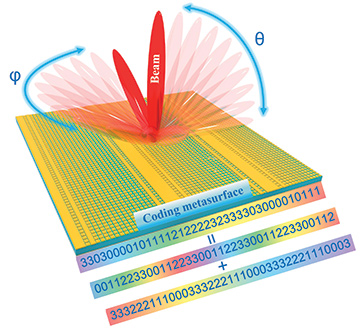 Coding metamaterials can allow steering of a scattering beam to arbitrarily pre-designed direction, with negligible distortion, using numerical convolution.
Coding metamaterials can allow steering of a scattering beam to arbitrarily pre-designed direction, with negligible distortion, using numerical convolution.
In the past decade, metamaterials and metasurfaces have been widely investigated to control electromagnetic waves, resulting in exciting phenomena such as negative refraction, invisibility cloaks and anomalous reflection and transmission. Previous studies of metamaterials, however, have been based on effective medium parameters, with the basic artificial structures characterized by continuous values.
Inspired by information science, we have proposed a concept of “coding metamaterials,” in which the metamaterial particles are assigned distinct binary “0” and “1” codes denoting opposite phases. The functionality of the coding metamaterial can then be controlled using the coding sequence of 0’s and 1’s. We have shown that coding metamaterials can manipulate scattering beams at will and can generate broadband diffusion of terahertz (THz) waves using Minkovski fractal coding particles.1
We also recently presented the concept, first design and experimental realization of polarization-controlled anisotropic coding metamaterials at THz frequencies.2 Because each coding element exhibits digital states 0 and 1 independently under the x- and y-polarizations, we are able to encode the anisotropic coding metamaterial with anisotropic coding matrices, to realize dual functionalities such as anomalous beam deflection and random scattering. The anisotropic coding metamaterial provides us another degree of freedom in control of scattering beams. This could be relevant to a variety of applications from the microwave to the visible wavelength band, such as a high-efficiency quarter-wave plate and beam splitter to enhance the transmission rate of wireless communications and the density of current storage media.
The digital quantization of coding metamaterials allows us to study them from the perspective of information processing. The information in coding metamaterials, for example, might be measured using Shannon entropy.3 Based on the coding pattern, we could easily estimate the average information carried by the coding metamaterial, which could prove helpful in new information systems in communications, radar, imaging and other applications.
Furthermore, we can also perform digital signal processing on coding metamaterials to realize unusual physical phenomena. We recently presented convolution operations on coding metamaterials that allow steering of the scattering beam to an arbitrarily pre-designed direction, with negligible distortion.4 In our numerical models, this new coding scheme enables a continuous scan of single-beam radiation in a half space above the coding metasurface. We believe that other digital-signal-processing algorithms could be exploited and applied to coding metamaterials, enabling more freedom in controlling electromagnetic waves.
Researchers
Tie Jun Cui and Shuo Liu, Southeast University, Nanjing, China
References
1. L.H. Gao et al. Light Sci. Appl. 4, e324 (2015).
2. S. Liu et al. Light Sci. Appl. 5, e16076 (2016).
3. T.J. Cui et al. Light Sci. Appl. 5, e16172 (2016).
4. S. Liu et al. Adv. Sci. 3, 1600156 (2016).
